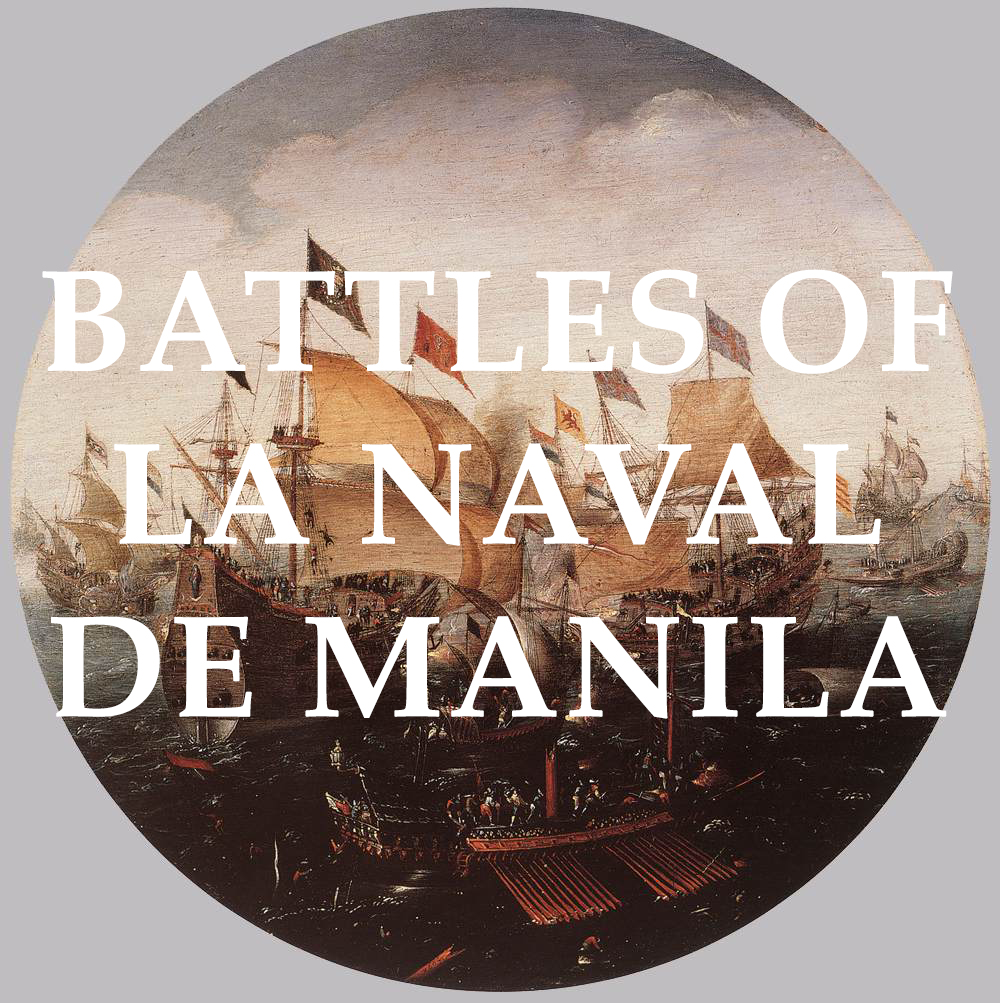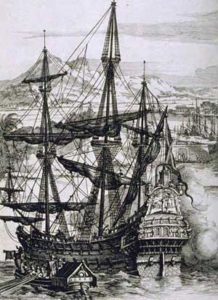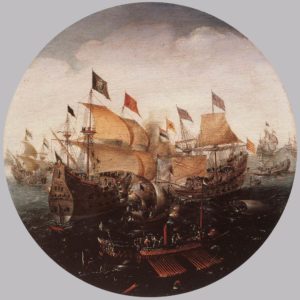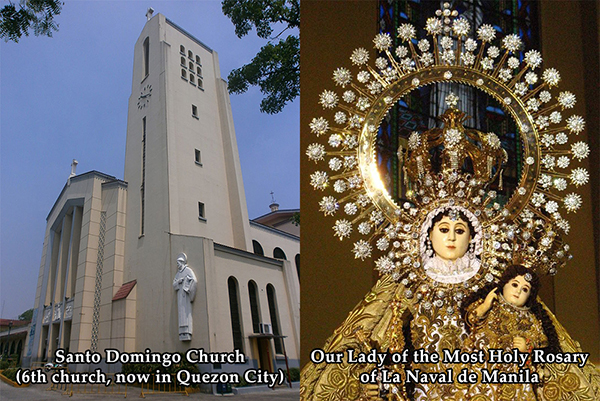
In 1646, the Dutch armada, one the most powerful naval fleet of its era, failed to invade Manila through a series of battles against the outdated Spanish-Filipino fleet. The battles were part of the Eighty Years War (1566 – 1648) and was won by Filipino volunteers and Spanish commanders against overwhelming odds in favor of the Dutch. These five battles would later be known as The Battles of La Naval De Manila and would be considered as one of the greatest naval victories in history and was even declared as a miracle by the Archdiocese of Manila after a thorough canonical investigation.
Prologue
During the Eighty Years War, the Netherlands was in revolt for independence against Spain. They were successful in ousting the political and religious hegemony of Spain. In line with this war and on its later stages, the Dutch wanted to expand their dominance of sea trade in South East Asia. They made numerous attempts in harassing the trade routes and galleons from Spain’s territories and colonies, particularly the coasts of Manila and the galleons shipping out of its bay. Other smaller traders dealing with Spain were also targeted like Chinese and Japanese traders, they even made plans to attack the galleons en route to Manila from Acapulco but those galleons escaped cleverly.
The Plan To Invade The Philippines
After contemplating on heavy losses and failures, the Dutch decided to amass its forces again for an invasion of the Philippines from the time they’ve conquered the island of Formosa (known today as Taiwan) in 1642.
The attack on the Philippines would come from Batavia (known today as Jakarta in Indonesia) with 18 vessels divided into three squadrons, each with specific destinations and objectives. The first squadron with 5 vessels was set for Ilocos and Pangasinan. The second squadron with 7 vessels including 800 ground soldiers was destined for Zamboanga. The Third squadron with 6 vessels were to support and reinforce the first two squadrons, then to be sent to Manila. Once all key objectives has been achieved, and after the weather has stabled after the monsoon, these squadrons would merge as one armada to conquer the city of Manila through its bay.
The biggest ships, which were the flagships, had 45 excellent cannons, while the smaller ones had 30. They were the best combat ships of its time.
Preparations of the Filipinos and Spanish
The first squadron of the Dutch fleet was successful in landing their troops in Ilocos and Pangasinan. They tried to persuade the natives to side with them, in return taxes would be abolished and independence would be given. The natives did not believed this and resisted and so the Dutch burned down their homes as a consequence. Spanish forces were able to arrive in areas where the Dutch were present and were able to fight them off to the point of retreating back to their ships.
Governor-General Diego Fajardo Chacón called for a council of war after news of Dutch presence arrived in Manila in February 1, 1646. Having no naval ships of war, the Governor-General order two old and rotting Manila Galleons to be hastily equipped with cannons and be manned for battle. The two galleons were the Encarnación as the flagship and Rosario as the admiral ship. Each ship was outfitted with at least 30 cannons and 200 men, which included musketeers, seamen, cannon operators, and laborers. The cannons for the galleons were actually outdated weapons that was supposed to be used as the main defense of Manila for any attack, which means the city of Manila became defenseless without them.
The Battles
First Battle
The Spanish-Filipino forces received reports of stationed Dutch ships at Mariveles, the northern entrance of Manila Bay. The galleons Encarnación and Rosario hunted the Dutch squadron but they were not able to make any visual contact. They then proceeded to Bolinao in the Illocos Region on March 15. There, the Spanish-Filipino forces discovered one enemy vessel by 9am but it managed to escape. They were able to track the ship by 1pm only to discover that it has regrouped with its fleet. The Manila Galleons are now facing four Dutch ships and they are now in full battle.
It was the Dutch flagship that fired the first salvo of cannon rounds, but it missed its target. The Encarnación fired back at the Dutch flagship, severely damaging it. All Dutch ships concentrated their salvo of canon fire towards Rosario while it fought back with its own cannon fires. The Encarnación managed to fire more volley of cannon rounds towards all enemy ships, inflicting more damage until the Dutch retreated by 7pm with all of their lanterns out to take advantage of the darkness of the night.
The Spanish-Filipino forces tried to hunt them again at the northern part of Luzon in Cape Bojeador, but the Dutch were nowhere to be found anymore. Both galleons proceeded back to Bolinao for repairs for the minor damages they received in the battle. No men died on the side of the Spanish-Filipino forces. They then received a new order by the Governor-General to secure an incoming merchant galleon from Acapulco called San Luis, on which they expected to come by July 21 and will take passage in the San Bernardino Strait.
By April, the second squadron of the Dutch arrived in Zamboanga, where they were able to steel two ships carrying relief goods. Part of their objective was to seize all merchant ships with their precious cargoes especially the ones from Acapulco.
The Dutch then proceeded to attack the fort in Zamboanga, but given its strong defensive measures, they were forced to lay a ground attack to the fort which ended in a disaster. 30 Spanish and two companies of Filipinos were able to repel the attack resulting to over a hundred deaths on the side of the Dutch. They were pushed back to their ships in retreat.
After their failure, the Dutch squadron with 7 ships decided to head to the San Bernardino Strait, where the Encarnación and Rosario were docked in its harbor awaiting the San Luis. The Dutch knew that the merchant ships from Acapulco would pass through that strait making it their key objective to secure. They planned to form a blockade on the harbor using their own ships so that the Encarnación and Rosario won’t be able to escape upon their discovery of them on June 23. But a day before their discovery of the two ships, they were already sighted by the Spanish-Filipino forces and an ambush was set at a high hill overlooking the entrance of the harbor. At 10 o’clock of June 23, the surprise attack of the Spanish-Filipino forces drove away the incoming Dutch fleet.
There were several attempts by the Dutch to capture the hill or damage the docked Encarnación and Rosario, but all strategic attempts failed and resulted to further casualties. Both the Spanish-Filipino and Dutch forces waited for the San Luis on a 31 day stand-off.
Second Battle
When the San Luis ship was still nowhere to be found, the Dutch made a decision to head for Manila early morning of July 25. Knowing that Manila is totally defenseless, both Encarnación and Rosario chased the Dutch fleet. The two rival fleets met between the islands of Banton in Romblon and Marinduque. On board the Encarnación was a priest named Fr. Juan de Cuenca, who in a soldier’s account said the priest seemed to be “in trance” and made spiritual sermons and assurance that on the part of God and His Most Holy Mother, victory is at hand and that no one would die in their ranks from that very ship. Both leaders of the ships Encarnación and Rosario, without each others knowledge, made the same pledge before their troops that if they win the battle, they will hold a solemn feast in honor of the Virgin of the Rosary, and all of them would walk barefoot to the chapel at Santo Domingo church as thanksgiving.
The battle took place on July 29 at around 7pm and was considered the bloodiest of all the 5 battles. The Encarnación was firing at all directions as it was surrounded by the 7 Dutch vessels in a circular blockade. The Rosario however, was outside the circle and was able to maneuver freely and pick its targets.
The Dutch once again suffered heavy damages and casualties. One of its most aggressive fire ships caught fire and sank killing all of its crew leaving one alive and later became a prisoner of war. The battle lasted until next day’s morning when the Dutch has fled. No one in the Encarnación died as promised by the priest, but five men lost their lives from the Rosario ranks.
Third Battle
Next day, July 31, the Spanish-Filipino fleet was able to track the remaining 6 Dutch ships between the islands of Mindoro and Maestre de Campo. At around 2pm in the afternoon, the battle began with the Spanish-Filipino forces being on the offensive. The Dutch fleet was desperately on the defensive as they were cornered by the Encarnación and the Rosario.
Heavily damaged and continuously bombarded by cannon fire from both ships, the Dutch squadron made a daring but risky attempt to use its last fire ship to attack the Spanish-Filipino fleet. It was severely damaged earlier that it needed to be towed by the other ships and launches for it to maneuver properly. As the Dutch fire ship came closer, it was met with heavy cannon fire from the two Spanish-Filipino ships and the musketeers on board the Encarnación was ordered to fire at the Dutchmen towing the fire ship from the launches. In the end, the Dutch fire ship was destroyed and sank at the bottom of the sea. During the battle, the Spanish-Filipino troops shouted chants of “Ave Maria!” (Hail Mary!) and “Viva la fe Cristo y la Virgen Santisima del Rosario!” (Long live the Faith in Christ and the Most Holy Virgin of the Rosary!). This was both a prayer and a mental tactic to stay focus on times of stress. It was apparent that religious rivalry between the Catholics and the Protestants was a factor for high spirits in the moment of battle.
The Spanish-Filipino forces were impressed on how efficient their weapons were in combat and at the performance of their galleons considering that they were outdated and the Dutch had better vessels and equipment. The battle ended at around 6pm when the Dutch once again were able to escape under the cover of the night and the Encarnación and the Rosario did not suffer any casualties this time.
By orders of Governor-General Diego Fajardo Chacón after the news of victory, the Encarnación and the Rosario was ordered to dock at the port of Cavite for needed repairs and rest for the crew. They arrived in Cavite by August and without haste, immediately fulfilled their vow of pilgrimage to the church of Santo Domingo in Manila on barefoot. They were celebrated as heroes of Manila. The commander of the Spanish-Filipino fleet, General Lorenzo Ugalde de Orellana retired from service and was awarded with the highest honors, the other officers who served in the two Manila Galleons were also given honors and rank promotions.
Fourth Battle
The Spanish-Filipino fleet is now commanded by Sebastain Lopez, who was the previous captain of the Rosario. Another ship which was a galley, fitted with cannons and held a hundred infantry soldiers, was commissioned to the fleet.
A new galleon named San Diego was set to sail from Manila to Acapulco with precious cargo on board. On September 15, 1646, as it draw near Fortune Island, it was ambushed by three awaiting Dutch ships. The San Diego had to retreat to Mariveles then to Cavite as it was not properly equipped for combat and it had no escort. It was then remodeled with more cannons and joined the Spanish-Filipino armada under the orders of Governor-General Diego Fajardo Chacón. It was also ordered that the previous vow of pilgrimage after victory be renewed and continuous prayer of the Holy Rosary before the image of Our Lady be prayed aloud.
The next day, the Spanish-Filipino fleet set sail for another battle. The Encarnación, Rosario, the San Diego, and the galley with four brigantines formed as the new Spanish-Filipino armada. They were able to track down the Dutch fleet near Mindoro at around 4pm. The Dutch flagship was a gigantic ship with 40 cannons on each of its sides with several more on its rear. It was escorted by another huge galleon with less cannons and another smaller ship which seemed to be a fireship according to its capabilities. The rival navies were too distant from each other that the battle had to be fought in long ranges for five hours. Then at around 9pm, the Rosario drifted closer to the Dutch fleet until it was cornered. It had to fight furiously on all sides to survive the ordeal while the other Spanish-Filipino ships were too far to help in the fight. Eventually the Rosario was victorious and the the three Dutch vessels had to withdraw and escape to Cape Calavite.
During the whole battle, the crew of the Spanish-Filipino fleet were loudly invoking the name of the Lady of the Rosary whom they deeply believed will intercede for them once more as she had in the previous battles.
Fifth Battle
On October 4, 1646, due to some defects, the San Diego, together with the galley and the four brigantines, was anchored in Mariveles for repairs. The Encarnación was station by the entrance of Manila Bay guarding the San Diego from a distance. The Rosario was caught by strong currents and it had drifted too far from the fleet.
When the Dutch saw that all rival ships were distant from each other, they seized the moment and spear headed for an attack. The Encarnación fought off the Dutch armada firing its cannons continuously to their position. The bombardment lasted for four hours and the Dutch came too close to the Encarnación that they were almost able to go on board it. Eventually, the Dutch ships were heavily damaged and headed for another retreat but the winds suddenly stopped causing the Dutch to be immobilized. The San Diego fired its guns in support. The Spanish-Filipino galley was able to draw closer to the Dutch flagship and fire its cannons. The galley had fewer cannons than the Dutch flagship and was also smaller in size but it fought hard to the point that the Dutch thought that their ship has been defeated and they attempted to jump overboard. The winds came back right before the Dutch flagship could be fully destroyed and the crew of it took the opportunity to escape.
The Dutch vanished at night time. There was no casualties from the Spanish-Filipino galley but four died from the Encarnación due to close combat.
Victory
After the battle, the Spanish-Filipino forces returned to Manila to fulfill their vows. They marched on barefoot to the shrine of Our Lady of the Rosary in Santo Domingo church in Intramuros.
The Dutch abandoned their plans to invade the Philippines. They settled in Indonesia, establishing the Dutch East Indies.
On April of 1647, the victories were requested for Ecclesiastical investigations by the Dominican order to be declared as a miracle interceded by the Virgin of the Rosary. Five years later, in April 1652, the victories were declared miraculous by the Venerable Dean and Chapter and Ecclesiastical Governor in the vacant See of the Metropolitan Church of Manila.



